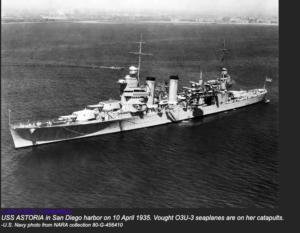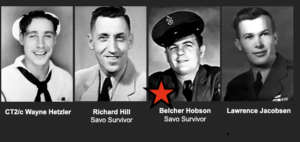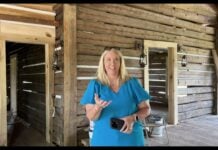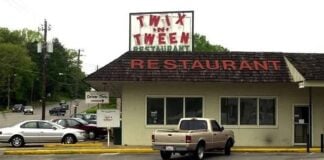Reported by Mike Hobson
As the clock ticked past midnight on the evening of August 8, 1942 the more than 800 officers and men of the U.S.S. Astoria (CA-34) knew they were in dangerous waters of the South Pacific. They could not have known they were about to be engaged in one of the fiercest and deadliest night time naval battles of World War II. These men had already participated in fierce naval combat at the Battle of the Coral Sea (May 1942) and the infamous Battle of Midway (June 1942), escaping both without serious harm or casualties.
Previously, Astoria arrived at Pearl Harbor in early 1941 and on the day of the infamous December 7, 1941 Japanese attack on the island they were at sea, heading towards Midway Island carrying Marine bombers. They escaped the death and destruction of Pearl Harbor but they knew there would be more violence to follow.

The Astoria was a Heavy Cruiser, commissioned in 1934 with a wartime complement of over 800 men. She had been part of a screening taskforce for the aircraft carrier Yorktown at both Coral Sea and Midway. In early August she became a part of the fleet allocated to the Marine landings on Guadalcanal and Tulagi.
On August 7 she supported the Marines as they landed on both islands. The Japanese responded in force during the night of August 8-9, sending seven cruisers and a destroyer to attack the Americans. The battle went badly for the Allies with four cruisers lost during the battle that was to later be named the Battle of Savo Island.
Astoria came under fire at about 1:50 a.m. while on night patrol near Savo Island, and was hit directly by more than 65 Japanese torpedoes & shells from a distance of over 5,000 yards away. The Japanese had successfully slipped by the U.S. patrols without detection and were experienced with expert night time gunnery. The U.S. fleet never saw the attack coming until the shells rained down upon them.
Astoria was set on fire, and eventually lost power, making her an easy night target. After heroic efforts to save the ship by the survivors, the Astoria finally succumbed and sank to the bottom by 12:15 p.m. of August 9. The Astoria lost 247 (sources vary on an accurate count) men to the battle and suffered 186 wounded. These numbers probably represent more than ½ of her officers and sailors aboard at the time.
Admiral Ernest King later said that Savo Island was the low point of the war for the U.S. Navy. It was not to be the last battle, only a beginning.
The U.S. went on to more heavy losses at Guadalcanal during the succeeding battles that were yet to come before turning the tide and succeeding against the Japanese. Heavy naval battles continued through the end of 1942 at Guadalcanal. The area of the first night time engagement became known as “Iron Bottom Bay” as a result of the heavy losses suffered by the U.S. and Japanese forces. Many rusting naval hulks remain on the bottom there today.

One of the survivors of the Battle of Savo Island was Bibb County native and Navy Chief Belcher Hobson. Assigned to a fire crew and wearing an asbestos suit he survived a direct hit into his compartment while scrambling to don his fire gear. Several shipmates perished in the explosion and fire.
Following the battle and the abandon ship order of the Captain, Hobson returned with a crew to attempt to save Astoria. She was damaged beyond repair and did not survive. Hobson spent the remainder of the war assigned to duty in the Atlantic ocean. He told his family that he was pleased to get the Atlantic assignment and had no desire to return to the South Pacific. Always minimizing his own horrific experience he glibly would say “It got rough out there”.
Belcher Hobson was not a victim of WWII combat. He safely returned to Bibb County after post-war years as a navy recruiter and continued his faithful service to his community. Utilizing and training others with the fire fighting skills he gained in the Navy he served as Chief of the Centreville Volunteer Fire Department for over 25 years. He served as Commander of local American Legion Post and remained active in the Naval Reserve. He served two terms on the City Council. He was active in civic clubs such as Civitan and Lions club. He launched three local small businesses. He managed a county unit of a gubernatorial campaign for well known candidates in the 1960’s. He became a rural mail carrier. He ran for public office. He became a member of the Masonic Lodge and the Zamora Shrine. He served his country and his community faithfully and well. He showed up daily at the community coffee table at the local drug store. He attended reunions of the Astoria survivors and maintained life long friendships with his ship mates. His lifetime of service only ended upon his eventual death.

During his final years he was proud to slip back into his “Navy Blues” and speak about military service to youth groups. He enjoyed his retirement years fishing with lifelong friends until the age of 89. He passed away peacefully in 2009.
As the battles in the South Pacific raged on thousands of men, Sailors, Marines, Officers, lost their lives in defense of our nation. Those men who served, those who perished, those who were permanently disfigured, and those who survived deserve our lasting respect and rememberance on this 2025 Memorial Day. The dedicated survivors who provided a lifetime of service to their communities after the great war also deserve to be honored and respected. The often used phrase that “freedom is never free” is never more appropriate than on a Memorial Day.
The Ghosts of Guadalcanal may be best remembered by the following moving poem, written by Father Walter Mahler, a Navy priest. This poem is not easy to read, it makes my neck tingle. And, it chokes me up everytime I read it. Try it for yourself……and report back.
I stood on a wide and desolate shore
And the night was dismal and cold
I watched the weary water rise
And the moon was a riband of gold.
Far off I heard the trumpet sound
Calling the quick and the dead
The long and rumbling roll of drums
And the moon was a riband of red.
Dead sailors rose from out the deep
Nor looked not left or right
But shoreward marched upon the sea
And the moon was a riband of white.
A hundred ghosts stood on the shore
At the turn of the midnight flood
They beckoned me with spectral hands
And the moon was a riband of blood.
Slowly I walked to the waters edge
And never once looked back
Till the waters swirled about my feet
And the moon was a riband of black.
I woke alone on a desolate shore
From a dream not sound or sweet
For there in the sands in the moonlight
Were the marks of phantom feet.
 MEMORIAL DAY 2025
MEMORIAL DAY 2025
WE WILL REMEMBER
References:
USS Astoria Sunk: The Disaster Off Savo Island – Warfare History Network
Guadalcanal, Battle of, Solomon Islands, 1942-1943 | U.S. Naval War College Archives















